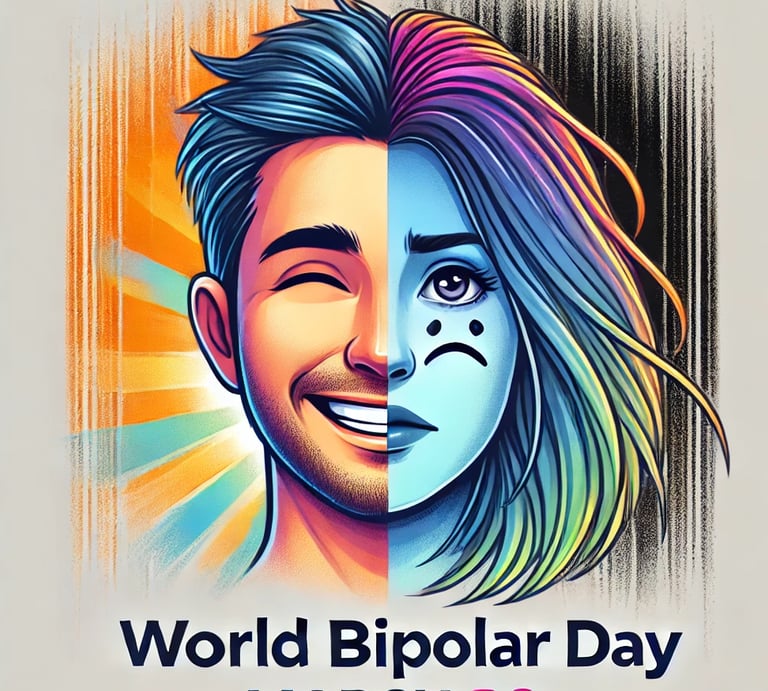

World Bipolar Day is observed every year on March 30th to raise awareness about bipolar disorder, a mental health condition affecting millions worldwide. This day aims to reduce stigma, improve understanding, and encourage people to seek appropriate treatment. At Al Haider Healthcare, we believe in spreading awareness to support individuals living with bipolar disorder and their families.
World Bipolar Day: Understanding, Management, and Treatment
What is Bipolar Disorder?
Bipolar disorder is a chronic mental health condition characterized by extreme mood swings, ranging from manic episodes (high energy, impulsivity) to depressive episodes (low energy, sadness, hopelessness). These mood changes can affect a person’s daily life, relationships, and overall well-being.
Types of Bipolar Disorder:
Bipolar I Disorder – Severe manic episodes lasting at least 7 days or requiring hospitalization, often followed by depressive episodes.
Risk Factors for Bipolar Disorder
While the exact cause is unknown, several factors increase the likelihood of developing bipolar disorder:
Genetic Factors – A family history of bipolar disorder increases the risk.
Brain Structure & Functioning – Abnormalities in brain chemistry and structure may contribute.
Environmental Triggers – Stress, trauma, substance abuse, or major life changes can trigger episodes.
Hormonal Imbalances – Certain hormonal changes may affect mood regulation.
Statistics
According to the World Health Organization (WHO) and Centers for Disease Control and Prevention (CDC):
Bipolar disorder affects approximately 40-50 million people worldwide.
The lifetime prevalence of bipolar disorder is about 1-3% globally.
It is one of the leading causes of disability among mental health disorders.
Management and Treatment of Bipolar Disorder
Although bipolar disorder is a lifelong condition, early diagnosis and proper treatment can help individuals manage their symptoms effectively.
Medical Treatment
Mood Stabilizers – Lithium, valproate, and lamotrigine help control mood swings.
Antipsychotic Medications – Used for severe manic or depressive episodes.
Antidepressants – Sometimes prescribed alongside mood stabilizers.
Psychotherapy (Talk Therapy) – Cognitive Behavioral Therapy (CBT) and Interpersonal Therapy (IPT) can help patients cope with symptoms.
Lifestyle Changes for Better Management
Regular Sleep Schedule – Helps regulate mood and prevent episodes.
Healthy Diet & Exercise – A balanced diet and physical activity improve overall well-being.
Stress Management Techniques – Yoga, meditation, and mindfulness can help control triggers.
Avoiding Alcohol & Drugs – Reduces the risk of triggering manic or depressive episodes.
Support System & Therapy
Family & Peer Support – Strong social support helps individuals cope better.
Self-Help Groups & Counseling – Helps share experiences and coping strategies.
Psychoeducation – Understanding the condition enables better self-management.
Conclusion
Bipolar disorder is a manageable condition with the right combination of medication, therapy, and lifestyle changes. On World Bipolar Day, let’s pledge to create a society that supports mental health awareness and provides care, understanding, and hope to those living with bipolar disorder.
For more information and support, visit Al Haider Healthcare (ahchospital.in) or consult a healthcare professional.
References
World Health Organization (WHO) – https://www.who.int
Centers for Disease Control and Prevention (CDC) – https://www.cdc.gov
National Institute of Mental Health (NIMH) – https://www.nimh.nih.gov
Ministry of Health and Family Welfare, India (MoHFW) – https://www.mohfw.gov.in
Bipolar II Disorder – Less severe manic episodes (hypomania) and prolonged depressive episodes.
Cyclothymic Disorder (Cyclothymia) – Frequent mood swings that do not meet full criteria for Bipolar I or II.
